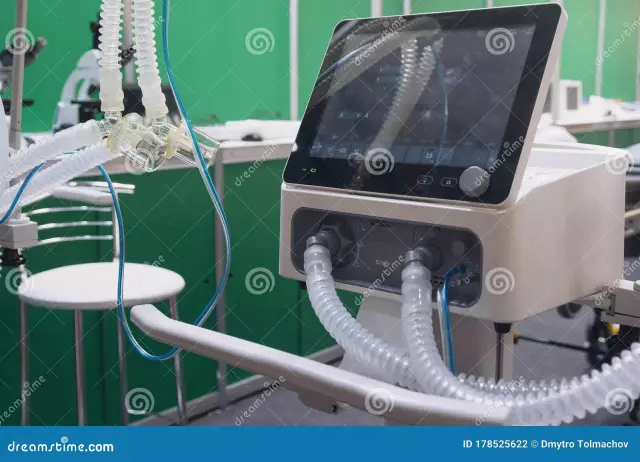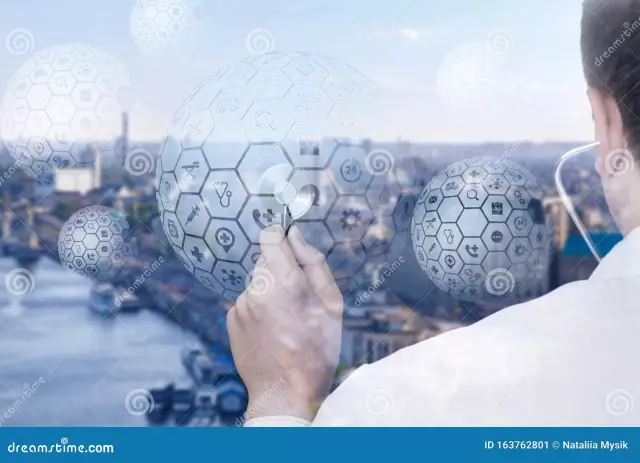- Author Curtis Blomfield [email protected].
- Public 2023-12-16 20:44.
- Last modified 2025-01-23 17:01.
Artificial liver is not quite the right name. Since modern science cannot yet recreate this organ. The liver is too complex for this and performs a huge number of functions. For example, the main function of the kidneys is to excrete excess water and substances from the body. It is the function of removing toxic substances that is performed by an artificial kidney. The artificial heart performs this function by pumping blood to all organs. The liver performs over a hundred functions. It is almost impossible to create a device that performs so many functions. However, the devices exist, are produced in several countries, and have already helped many people. Let's figure out what artificial liver machines do, how they differ from each other.
Liver failure
The main pathology of the liver faced by doctors around the world is insufficiency. The main causes are viral lesions - hepatitis B and C, alcohol intoxication, and long-term use of drugs, mainly paracetamol, and poisoning with toxins can also cause pathology. Liver failure is a condition where the organ cannot maintain a constant internal environment and metabolism of substances.

The complexity of the treatment lies in the fact that all the measures that the doctor can take (elimination of blood clotting disorders, hypoxia, normalization of the water-s alt balance and acid-base state) do not improve the patient's condition. The basis of the course of the disease is the accumulation of toxic substances, different in chemical composition, solubility and target organs. All these substances do not periodically enter the body, but are the waste products of the body itself. This means that toxins are constantly accumulating, and to keep the patient alive, they must be constantly removed.
Modern methods of treating liver failure
The only radical way to eliminate liver failure is a liver transplant. However, even in Europe, about 15 thousand people die every year without waiting for this operation: the number of donors and recipients of the liver is completely different.
The course of liver failure is based on the death of liver cells (hepatocytes) under the influence of damaging factors (viruses, drugs, etc.). The appearance of clinical signs of liver failure indicates that 80% of hepatocytes are no longer functioning. Liver cells recover well, but for this they need to temporarily remove the load and take over their functions. That is, the main task of treating patients is to create conditions for the regeneration of hepatocytes. For this, in modernmedicine uses several extracorporeal (that is, "out of the body") treatments. These methods can be divided into two groups: biological and non-biological.
Biological methods to maintain liver function
Imply the use of live hepatocytes taken from animals, stem or cancer cells. The devices process such toxic waste products as ammonia, bile acids, bilirubin. Several liver support systems have been created on the cellular principle: N. Yu. Korukhov's "auxiliary liver", "auxiliary artificial liver", "bioartificial liver support system" and other biological systems.
Apparatuses are hollow tubes with hepatocytes through which the patient's blood or plasma passes. The blood during its passage through the tube comes into contact with hepatocytes, which render it harmless. The purified blood is then returned to the human body.

Cell Source is the most discussed topic. Most Promising Options:
- liver cells taken from live pigs have a short lifespan;
- human fetal stem cells raise ethical questions;
- cancer cells are a promising option.
The advantage of artificial liver biological systems is that they not only neutralize toxins, but also perform other functions of the liver: they participate in metabolism, synthesize a number of substances, deposit blood, participate in antibacterial protection. Disadvantages of using live cellsare the complexity of working with them and, accordingly, the high price of the systems, the need to include additional devices in the device to provide cells with oxygen.
Currently, a US-developed cancer cell-based artificial liver device, ELAD, is being used in several countries.
Non-biological methods to support liver function
Imply the use of methods based on adsorption and filtration, replacing the neutralizing function of the liver. These include:
- hemodialysis;
- hemofiltration;
- hemosorption;
- plasma exchange;
- molecular adsorbent recirculating system ("MARS");
- separation and adsorption of fractionated plasma ("Prometheus").

These methods have their drawbacks: the first three methods of replacing liver function reduce the concentration of certain toxins in the blood, but in general do not ensure the survival of patients. Palazmoobmen is more effective, but it requires a large amount of donor plasma, which leads to the risk of infection with viruses, including immunodeficiency and hepatitis. It also slightly reduces mortality. It is worth noting that the first four methods have many negative effects on the patient's body.
Prerequisites for the creation of "MARS" and "Prometheus"
The main cause of death in patients with liver failure is intoxication of the patient with waste products, causing jaundice,hepatic encephalopathy (brain damage), hepatorenal syndrome (simultaneous damage to the liver and kidneys), hemodynamic disturbances and, in many cases, failure of many organs and systems. Mortality in acute liver failure reaches 90%.

Toxic foods can be divided into two groups:
- water-soluble - ammonia, tyrosine, phenylalanine;
- Water insoluble, usually associated with albumin: bilirubin, bile acids, fatty acids, aromatic compounds.
Moreover, the liver synthesizes mainly substances of the second group.
Existing methods of extracorporeal support of the liver - hemodialysis, plasma exchange, hemofiltration and hemosorption - allow you to remove from the blood only predominantly water-soluble substances. Thus, water-insoluble toxic substances associated with albumin remain in the blood.
The development of modern medicine makes it possible to combine the applied extracorporeal methods of therapy and create a new generation of artificial liver. It is these life support systems that are now being used in many countries.
Prometheus System
In 1999, an artificial liver system called Prometheus was developed in Germany. The principle of its work is based on a combination of two methods of extracorporeal treatment:
- hemadsorption - separation of blood plasma into separate fractions (separation) and adsorption of toxins on the albumin fraction;
- hemodialysis - cleansing the blood with a filter.

Separation is carried out using a filter that is permeable to albumin, which is small in size and does not allow cells and large molecules to pass through. Further, the albumin with toxins separated from the blood passes through the system of adsorbents, where these toxins remain, and the albumin itself returns to the patient's blood. Thus, water-soluble substances are removed by hemodialysis associated with albumin - haemadsorption. Thus, the artificial liver system "Prometheus" supports the neutralizing function of the organ, thereby facilitating the regeneration of hepatocytes.
Prometheus devices are used in many countries, including Russia. For example, it is used in the Center for Surgery of the Ministry of He alth of Russia.
Mars system
Artificial liver "MARS", developed in the 90s in Germany, like "Prometheus" combines sorption and dialysis. But the cleaning method is different. The patient's blood enters a membrane that is permeable only to small molecules of toxins. They pass through the membrane and bind to donor albumin. The purified blood is returned to the patient's body. The albumin associated with toxins is purified by passing through the adsorbent complex and returned to the system. Thus, the difference and the main advantage of the Mars artificial liver is that albumin can be reused.

"MARS" has been successfully used in Russia since 2002. There are artificial liver devices in Moscow in several clinics, for example, in the Scientific Center for Cardiovascular Surgerythem. Bakulev has both Prometheus and MARS.
Despite the constant search for new methods for creating artificial liver devices, some of them have already proven their effectiveness and are successfully used in many countries, including Russia.






